
Do you know what SIPOC stands for?
Go on, have a guess…
To clarify, SIPOC is an acronym for Suppliers, Inputs, Processes, Outputs, and Customers.
The SIPOC methodology acts as a tool to identify the inputs and outputs of target business processes, to determine the process owner, customers, suppliers, and to establish clear boundaries for the process.
Numerous case studies have shown the utilization of SIPOC to give substantial process improvements. For this reason, we at Process Street present you with this ultimate SIPOC guide, explaining the what, why, and how of SIPOC, with free templates to help you get started.
Click on the relevant subheaders below to jump to that section, alternatively scroll down to read all we at Process Street have to say regarding SIPOC.
- What is SIPOC?
- SIPOC Template
- The benefits of implementing SIPOC methodology
- Creating a SIPOC diagram with our SIPOC Template
- SIPOC example
Alternatively, if you want to skip all of the info and get straight to the free SIPOC Template, you can check it out below.
What is SIPOC?

SIPOC is a methodology used in process management and improvement. The acronym stands for:
- Suppliers
- Inputs
- Processes
- Outputs
- Customers
Using this acronym, a business process is followed from the beginning of its supply chain right through to the point of sale, customer care and interaction. The information obtained during the implementation of SIPOC methodology:
- Gives a high level overview for people unfamiliar with a certain business process
- Reacquaints people whose familiarity with a process has faded or become out of date
- Helps to define a new process
- Identifies suppliers and customers internal or external to the organization
- Emphasizes the inputs of the business process and the business process outputs
Evidence of the SIPOC methodology dates back to the late 1980s. During this time, the method was used in quality management systems. Today SIPOC is used in Six Sigma, Lean Manufacturing, and Business Process Management.
The SIPOC methodology is used to create a SIPOC diagram, like the example detailed below. While it’s an empty shell at the moment, I will show you how you can use Process Street’s SIPOC Template to fill in the details.
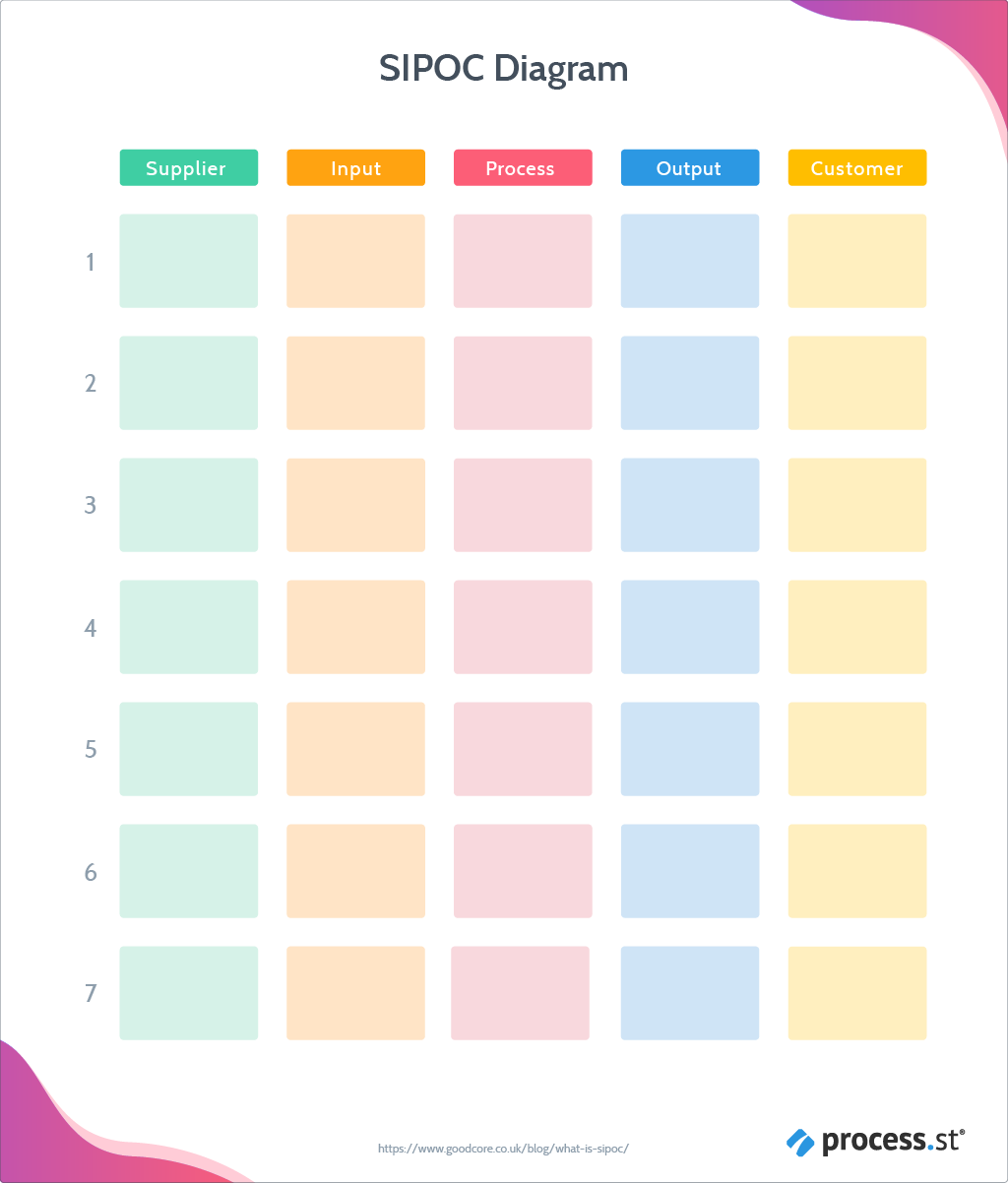
SIPOC Template
I’m not one to beat around the bush so to speak. Therefore, to kick-off this post, I present to you – drum roll, please …
…Process Street’s SIPOC Template
Your ultimate assistant for the implementation of SIPOC methodology, to improve processes in your business.
By using this template, you will:
- Identify the overall processes in a working system.
- Gain better insight into your business processes.
- Support the definition, structuring, and scoping of complex work systems.
- Highlight possible problems or weaknesses in the processes of the work system.
Keep reading and you will witness this template in action
Click here to access the SIPOC Template!
On knowing what SIPOC is and why it is used, our next question asks: What benefits does the SIPOC methodology bring and why should you use it?
The benefits of implementing SIPOC methodology
Here’s a quick summary of the benefits that SIPOC methodology brings to a business:
- The most basic information related to a business is revealed, giving a high-level overview
- Process information can be quickly conveyed to new employees
- Process updates are clearly and easily given
- It acts to kick-start problem-solving in business
- Key information is clarified in a team, such as the suppliers of a process, input requirements, true customers, and specifications for the end product
The above are all self-explanatory. However, there are two more benefits I wish to expand on; how SIPOC builds the foundation for the creation of a process map, and how SIPOC sets the ball rolling for the implementation of a Six Sigma DMAIC strategy.
SIPOC builds the foundation for the creation of a process map
The first is that the SIPOC methodology is the first step to creating a process map.
A process map is a visual representation of a business process, used for business process management and planning. If you wish to use SIPOC alongside the creation of a process map, hop into our SIPOC Template, and use this alongside our Creating a Process Map from Scratch template.
Click here to access the Creating a Process Map from Scratch template!
SIPOC sets the ball rolling for the implementation of a Six Sigma DMAIC strategy
SIPOC sets the foundation for the Six Sigma DMAIC strategy. The goal of Six Sigma methodology is to yield defect-free processes, with the sigma level indicating the extent to which an organization has attained defect-free process.
For more information on Six Sigma DMAIC, read our following resources:
- The 7 Core Six Sigma Principles to Build Your Business Around
- DMAIC: The Complete Guide to Lean Six Sigma in 5 Key Steps
- 14 BPM & Six Sigma Courses You Can Take to Become a Systems Expert
- DFSS: How Design For Six Sigma can Supercharge Your Business
Creating a SIPOC diagram with our SIPOC Template
Above you were introduced to Process Street’s SIPOC Template. With this template you are guided through the SIPOC process, so you can continually improve your business processes and realize the benefits given above.
With that said, its time we moved onto implementing SIPOC for your business and line of work.
Let’s work together and bulk out that empty ⬆ SIPOC diagram ⬆ from earlier.
With Process Street’s SIPOC Template, you can identify all relevant elements of a process improvement project as per the SIPOC methodology. The information gathered as you run this template can be compiled into a SIPOC diagram.
Click here to access the SIPOC Template!
Right, let’s get to work!
To exemplify how to use Process Street’s SIPOC Template, I will implement the SIPOC methodology for our content creation processes.
SIPOC diagram: Use Process Street’s SIPOC Template to create your SIPOC diagram
Process Street’s SIPOC Template is structured as per the recommended order of approach to SIPOC. You start the checklist with the identification and documentation of business processes.
You then need to specify the outputs from each process, determine the customers for the outputs, identify the required inputs, and gather supplier information.
On completion of the SIPOC Template, you will be presented with a results summary, as given below.
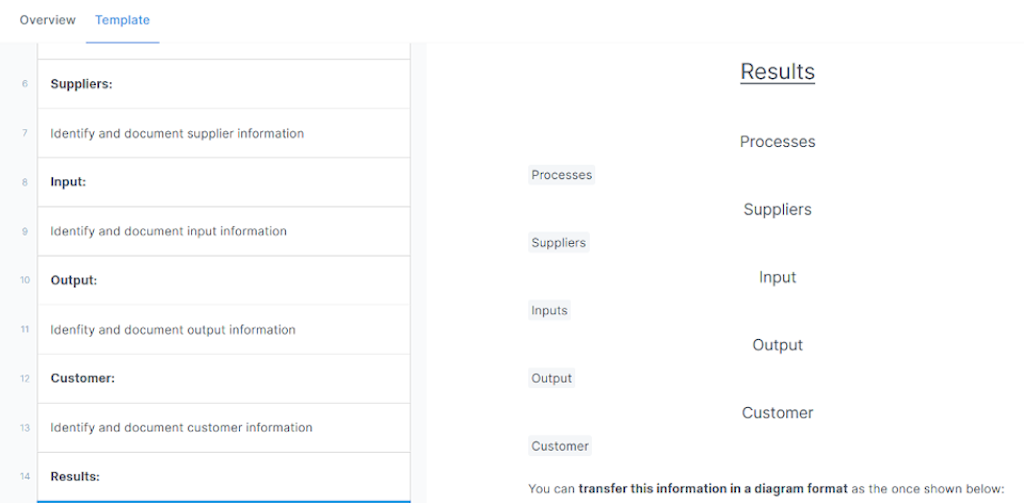
The information from this results summary can be used to produce a SIPOC diagram if this format is required.
It really is as simple as that!
Don’t believe me? Well, let’s dive into an example…
SIPOC example
Putting Process Street’s SIPOC Template in action, I will run this checklist for our content creation process.
Step #1: Document your process
To begin with, it is good practice to describe your business processes from start to end before beginning the SIPOC analysis. For this, we recommend documenting your processes in Process Street.
If you are new to Process Street and a little unsure about what it is we offer, watch our below webinar: An Introduction to Process Street.
With Process Street you can document any process in a checklist format. Include features such as:
- Stop tasks to ensure task order.
- Dynamic due dates, so no deadline is missed.
- Conditional logic, creating a dynamic template that caters to your needs.
- Role assignments, to ease task delegation within your team.
- Approvals, allowing decision-makers to give the go-ahead (or rejection) on important items. Also, the necessary comments can be provided.
With these features, you can create dynamic checklist machines, adaptable to your unique processes.
For more information on how to create and edit templates with Process Street, watch the below video: Basics of Creating and Editing Templates.
For content creation, we have several documented processes that I and my fellow teammates follow. Each process is a requirement, producing daily quality content for our readers – that includes you, hello .
Examples include our:
- Content Creation Editing Process
- Content Creation Pre-Publish checklist
- Planning Process checklist
Step #2: Condense your documented process into a few steps
- You have documented your process ✅
Next, condense your processes into a few simple steps. If you’ve documented your processes with Process Street, a great way to do this is to take just the titles of each task in your checklist.
So, taking the Content Creation Editing Process as an example, this process can be condensed as shown below.
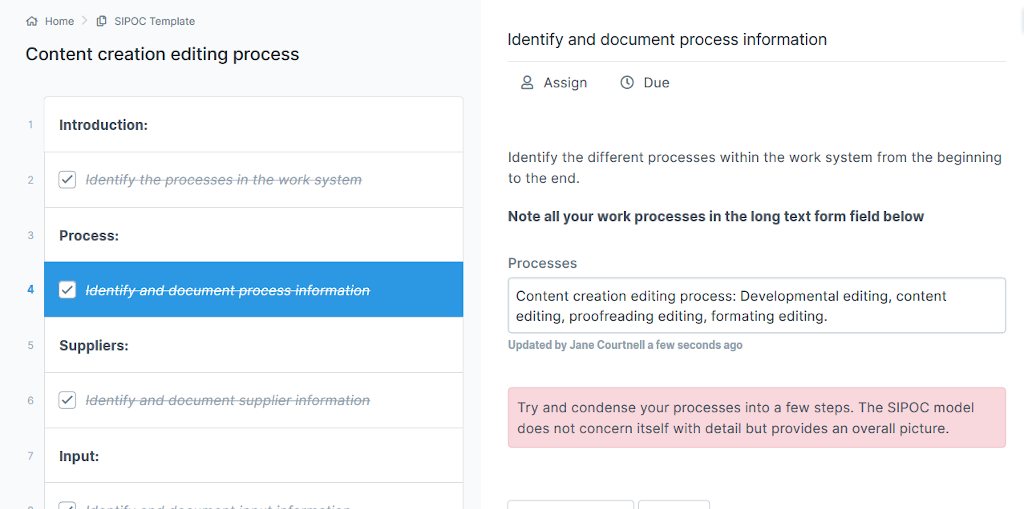
Step #3: Identify and document supplier information
- You have documented your process ✅
- Your documented processes have been condensed into a few steps ✅
Next you need to identify suppliers for the business process inputs. These could be people, machines, internal and external stakeholders, and even other linked processes.
Detailing this information for our Content Creation Editing Process, you can witness the identified suppliers in the image below.
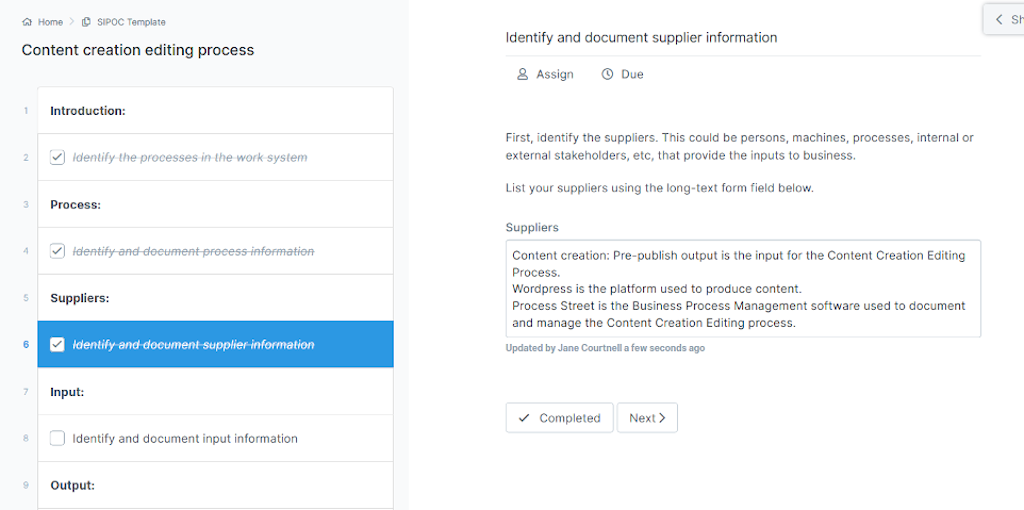
Step #4: Identify and document input information
- You have documented your process ✅
- Your documented processes have been condensed into a few steps ✅
- You have identified and documented supplier information ✅
The next step you need to carry out is to identify the required inputs for each process step. This includes materials, data, workforce, knowledge, and information.
This has been done for the Content Creation Editing Process, as shown in the image below.
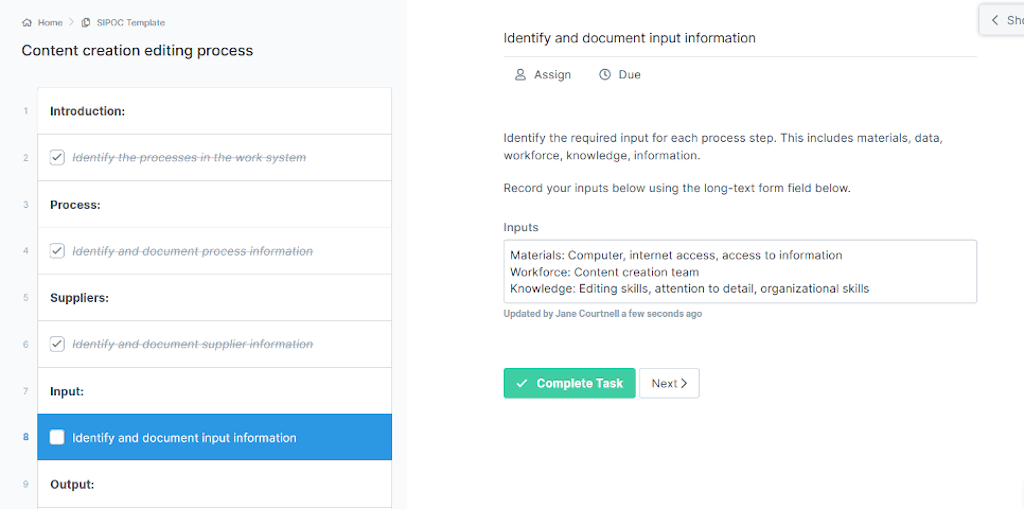
Step #5: Identify and document output information
- You have documented your process ✅
- Your documented processes have been condensed into a few steps ✅
- You have identified and documented supplier information ✅
- You have identified and documented input information ✅
You’re almost done – next you need to identify the expected outputs for each process step. This could include yield, information, service, knowledge, or materials.
I’ve identified and documented the outputs for our Content Creation Editing Process as shown below.
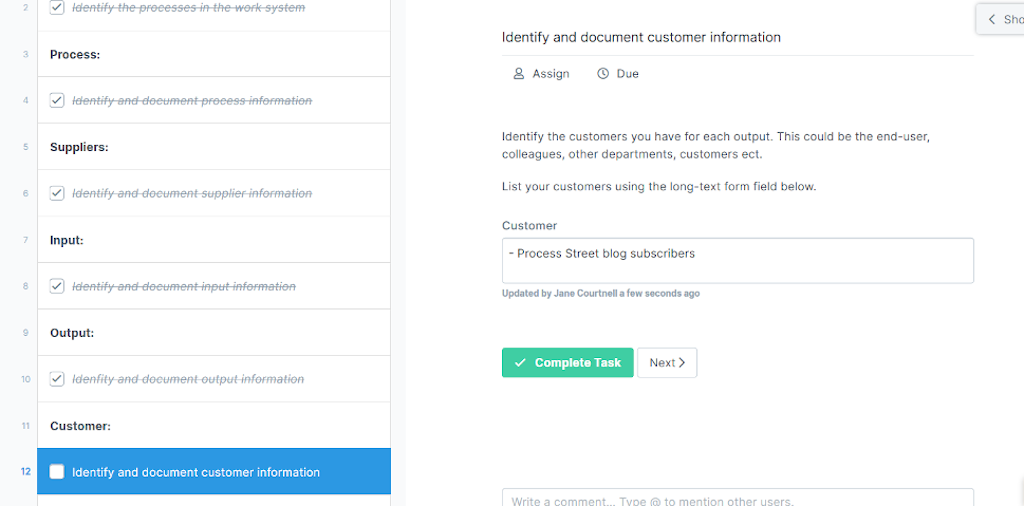
Step #6: Identify and document customer information
- You have documented your process ✅
- Your documented processes have been condensed into a few steps ✅
- You have identified and documented supplier information ✅
- You have identified and documented input information ✅
- You have identified and documented output information ✅
The final step is for you to identify the different customers for each output. This could include the end-user, other departments, or colleagues.
Once again, the customers for the Content Creation Editing Process have been recorded in the checklist as shown below.
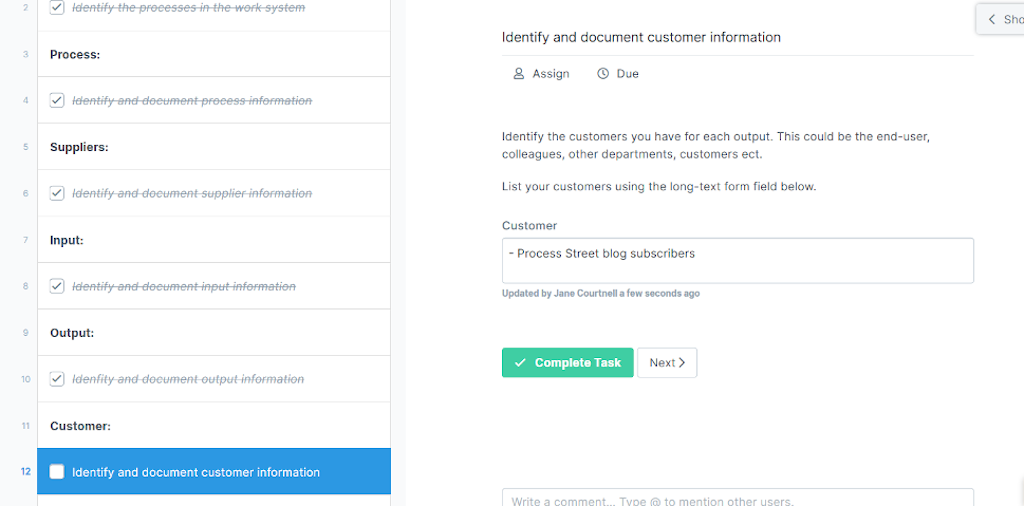
That’s everything you need to assess for the SPIOC Template!
This information is then automatically compiled together into a final results report, ready for you to review whenever you need to.
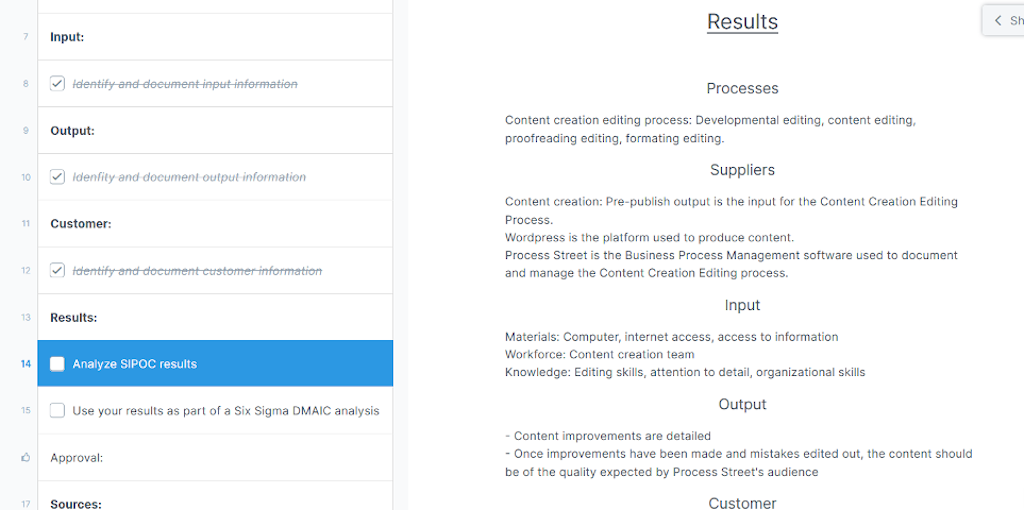
To then fill out the SPIOC diagram, all you have to do is copy your results into the appropriate column and row. You can see the result of our example transferred into the diagram below.
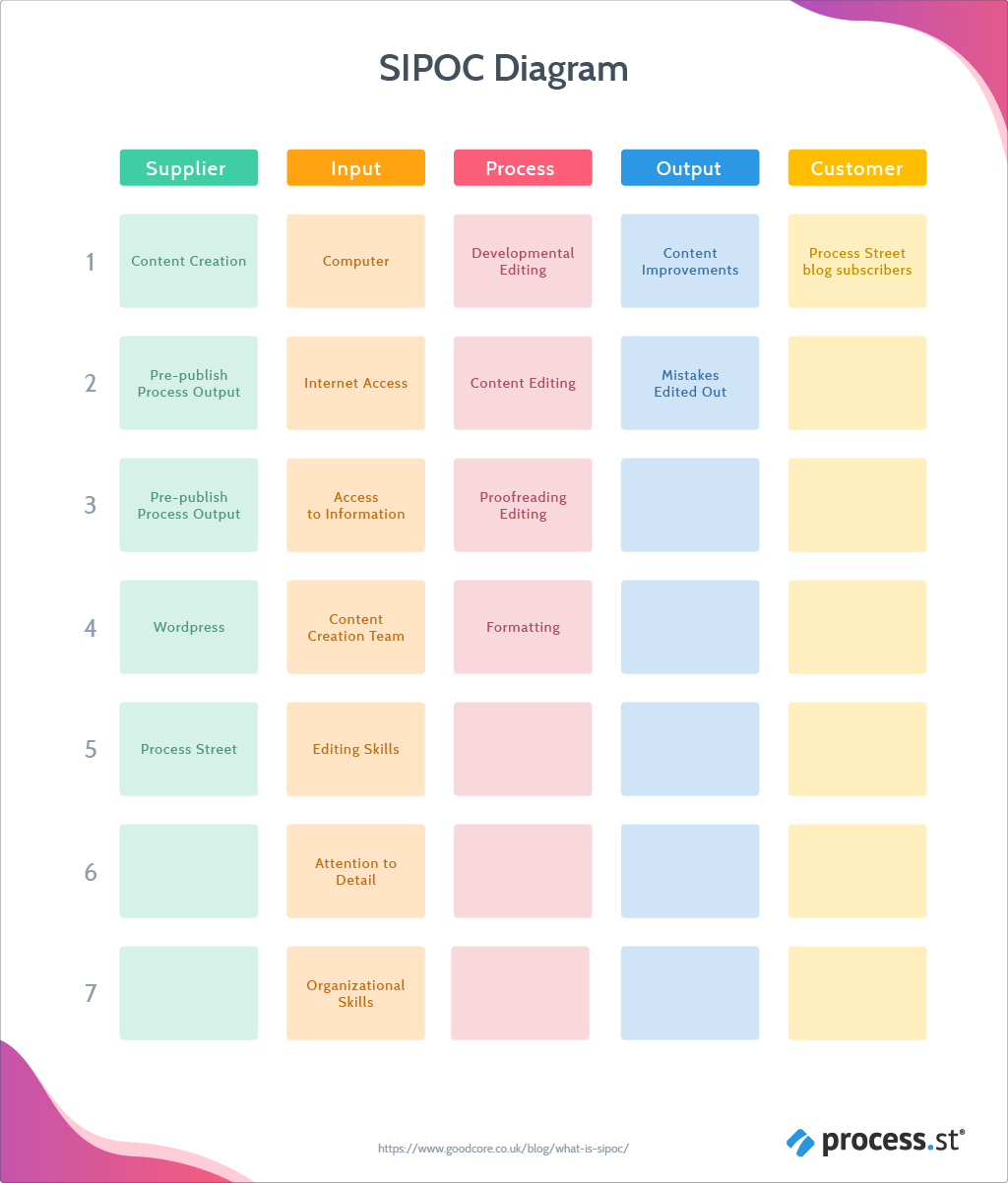
You can see how easy it is to implement the SIPOC methodology with Process Street’s SIPOC Template. All you have to do is follow the step-by-step instructions in the template, then copy your results into our fancy diagram!
Use Process Street for SIPOC analysis and business process improvements
Congratulations!
From reading this article you should have a clear understanding of what SIPOC is and why it is needed.
By using our SIPOC Template, you can implement SIPOC methodology for your business processes, to manage and improve these processes for continual business progression, advancement, and success.
By working through the example given, you have witnessed Process Street’s SIPOC Template in action. You have seen how the information gathered in this template can be transferred to create a SIPOC diagram.
SIPOC highlights key business suppliers, inputs, processes, outputs, and customers. With this information, you can obtain an in-depth overview of your business operations, useful and vital to succeed in the business world.
How do you measure, manage, and improve your business processes? What methodology do you implement? Have you used SIPOC before? If so, what challenges and successes have you experienced? We would love to hear from you, please comment below.







Jane Courtnell
Hi there, I am a Junior Content Writer at Process Street. I graduated in Biology, specializing in Environmental Science at Imperial College London. During my degree, I developed an enthusiasm for writing to communicate environmental issues. I continued my studies at Imperial College's Business School, and with this, my writing progressed looking at sustainability in a business sense. When I am not writing I enjoy being in the mountains, running and rock climbing. Follow me at @JaneCourtnell.